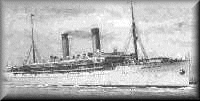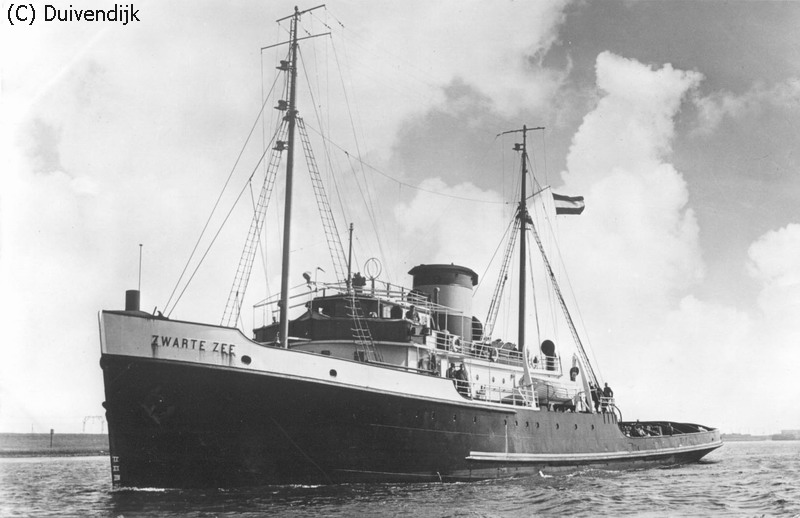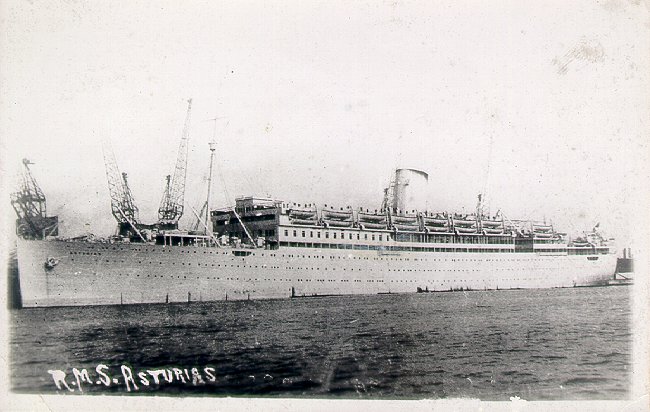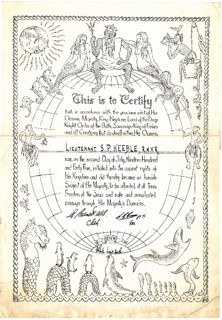R.M.S. EDINBURGH CASTLE (2)
RMS Edinburgh Castle was built in 1910 by Harland & Wolff at Belfast with a tonnage of 13362grt, length of 570ft, a beam of 64ft 5in and a service speed of 14 knots. Sister of the Balmoral Castle she was the last of a group of almost identical ships and replaced the Norman.
On 14th August 1914 she sailed from Cape Town with mail and government only passengers to Gibraltar where she embarked troops before being escorted to England by HMS Minerva. She was then taken over as an auxiliary cruiser for the South Atlantic patrol and in January 1915 sailed from Devonport for South Africa with White Star's Ceramic to hunt for the German ships Karlsruhe and Kronprins Wilhelm.
In 1918 she served in the North Atlantic on convoy work. She resumed commercial operations in 1919 after a refit and during that year carried General Smuts back to South Africa.
She was withdrawn from service in 1938 and laid up at Netley until she was bought by the Admiralty for use as an accommodation ship in Freetown, Sierra Leone for Naval personnel and survivors of sunken ships. In 1945, as towing back to England would not be cost effective, she was towed 60 miles out to sea by the tug Empire Lawn and sunk by gunfire and depth charges from the armed trawler Cape Warwick, HMS Porchester Castle and HMS Launceston Castle.
Several incidents happened while we were in Freetown but there does not appear to be any way they can be dated except from the Ship's Log. (Ships Logs aren't kept at either the Public Record Office or at the Naval Museum Portsmouth.) On the West African Station Officers were permitted to carry Umbrellas but there was no definition of size or colour--I think the result is best left to the imagination. Also the Wardroom was permitted to employ a D'hobi Boy which we did.
The Lad we employed was first class. He was a half caste, his Father {English} had been an Army captain in the First World War, and as far as we could gather had stood by his Mother but had died when the Lad was small. He was an exceptionally pleasant lad - so much so the Ships Company allowed him to join them on the Mess Deck and not have to manage under the 4inch Gun Deck.
Any trips ashore had to be by Liberty Boat as there was no jetty in Freetown other than for small boats and it was on the liberty boat that the tragedy occurred. Some
of the ships Company had been ashore with the Dhobi Boy [ visiting his house] and were returning on the Liberty Boat when a drunken stoker from another Ship said 'You Black Bastard" and pushed him overboard .He didn't stand a chance - there was a 5 knot current. The whole of our Ships Company was devastated. He was replaced by the standard native dhobi boy who slept under the 4 inch Gun Deck.
Photo of second D'hobi Boy
We had one other unfortunate occurrence whilst on the West African station - I believe it happened in Freetown. We were practicing Action Stations when one of the for'd Oerlikon Guns fired one round, unfortunately it exploded by the after gun platform wounding one of the Ratings {A.B. Seaman Campion ? ]. He had to be Hospitalised and left the Ship . I am pretty certain that it was not a serious injury but I have no recollection of the outcome. We never understood how this occurred since there were railings to prevent the gun pointing in dangerous directions.
During our visits to Lagos the Wardroom had become friendly with an English family living there and we were invited to relax in their Garden, which we did and we reciprocated by inviting them on board for a drink.
S/Lt Keeble, Lt Lilley, S/Lt Gardiner
S/Lt Keeble, S/Lt Gardiner ,Lt.Cdr Locke
This had a very pleasant outcome for the Ships company. Over Christmas 1944, we were in Lagos tied up third ship out from the Jetty. On Christmas Day we invited the family aboard and they brought with them an Army Officer, an entertainer, Phyllis Robbins, and her Pianist. During the course of conversation it turned out that Phyllis Robbins was with ENSA entertaining the Troops. We said how unfair that was since the Navy never got involved in anything like that. Phyllis Robbins said that she would give us a show providing we could light her well and have a Piano. The lighting was no problem - there were available six 20 inch searchlights and the same number of 10 inch signal projectors. The snag was no Piano; the Army said they would lend us one but how did we get it aboard that evening over 20 yards of grass, along a wooden Jetty, across three ships and onto our Foc'sle. We passed the problem to the Ch. Bos'n Mate .The Piano duly arrived (how I don't know) and the three Ships Companies (probably over 200 people) had a Christmas Day Concert. Unfortunately, Phyllis Robbins had made the mistake of asking the audience to come closer, which they were very glad to do - but came rather TOO close. Also she found the lights a bit excessive and had them turned down. Earlier in the day we had the traditional event where the Captain changed places with the Junior Rating (Ord Sea Tierney} on board. The new? Captain then carried out Captains Rounds The following is a record of the event.


Lt.Cdr Locke
Friend, O.S Tierney {Capt for the day]
Lt. Lilley, L.Sea Howells, Friend ,? ,Ord Sea. Tierney ,L.Cdr.
Locke ?.
After Christmas we resumed our humdrum existence escorting Convoys. to and from Freetown but there were two exceptions to our normal routine. It was probably early 1945 we docked in Freetown's Floating Dock. It was a most unpleasant experience - minimal power, hot and very humid, smelly and confined. There may have been a slight advantage since each watch had a few days leave in a Rest Camp. Round about the time we came out of Dock the Group was instructed to escort the Tug Zwarte Zee and the damaged RMS Asturius to Gibraltar.
The journey to Gibraltar was uneventful.
Status: Sold for scrap to Hendrik Ido Ambacht, The Netherlands in 1966.
Company:L. Smit & Co's Internationale Sleepdienst, Rotterdam
Renamed:"Zwarte Zee III" in 1961, "Ierse Zee" in 1962
Loa/Bm/Dft: 63.35 x 9.80 x -
Builder: Scheepswerf L. Smit & Zn., Kinderdijk
Yard number: 872
Year:1933
GT:793
Eng make:Werkspoor
Power:2279 kW
this page is part of the Duivendijk site,
Copyright © 1998 - 2005 Leon van Duivendijk. All rights reserved.
Last updated: maart 12, 2005.
R.M.S. Asturias (II)
This Asturias, the second Royal Mail Line ship of that name, was built by Harland & Wolff, Belfast and launched in 1925. Registered to Royal Mail Meat Transports, Ltd. (a Royal Mail Steam Packet Co. subsidiary), she made her maiden voyage from Southampton to La Plata (River Plate), Argentina, on 26 February 1926. In 1932, Asturias was re-registered to Royal Mail Lines, Ltd., together with the rest of the Meat Transports fleet.
Originally fitted with diesel engines, Asturias was refitted in 1934 with turbine engines, and made her first voyage as a steamer in September of that year. After being taken over as an armed cruiser in 1939, her forward funnel was removed, leaving her with only a single stack, as she is shown here. While serving in the South Atlantic in 1943, she was torpedoed and badly damaged by an Italian submarine, and was towed to Freetown, where she was abandoned as a total loss.
The British government took her over in 1945 and had her towed first to Gibraltar, and then to Belfast, for repairs and conversion into a troop carrier. After the war ended, she continued to serve as a troop transport and also saw service as an emigrant ship toAustralia. She was sold for breaking up in 1957. Interestingly, before being broken up, she was lent by the breaker, Thomas W. Ward, to the Rank Organisation for use in the film "A Night to Remember". Asturias' port side was used to depict Titanic in the lifeboat-lowering scenes of the film even as the shipbreakers were at work on the starboard side. Once filming was completed, demolition was as well.
The return trip was far from routine, Cowslip and Kilhampton had minor defects so stayed in Gibraltar for a few days whilst Wellington and ourselves returned to Freetown. On the first afternoon the Senior Officer decided to exercise towing- no problem more or less routine, The second afternoon was sheer chaos.. HMS Lowestoft passed us fresh water whilst underway--absolute bedlam but great fun. We developed a Gyro fault ( it wandered about 5 degrees either side of the true course) and had to divert to Dakar where it could not be corrected so we rejoined HMS Wellington and the rest of the Group only to find that Cowslip had broken down. [Her distillation equipment had ceased functioning]. We had no problem towing Cowslip with our wandering Gyro but it was rather different the next day. The defect was made good but Cowslip had insufficient water to flash -up her Boilers. So HMS Wellington decided to pass fresh water whilst we were towing [Gyro and all}. All went well, a well rehearsed operation, the only snag was a few rude signals about our steering.
The next notable occasion was on 8th May when the German surrender was announced but it was still routine as usual since the Area had not been declared clear of Japanese U Boats or even Germans who had not received the signal. However I believe it was our last escort duty. After VE. Day I don't think F.O.I.C , knew what to do with us. Then it seemed as if somebody on his Staff had the bright idea of using us as a Pleasure Boat to give some of the shore based staff a day at sea. So we became the Banana Belle for the day and welcomed aboard 50 or so shore based personnel and sailed for the Banana Islands [5-10 miles SW of Freetown}T

The person who dreamt up the idea had no idea of the implications. Firstly we didn't really have any facilities for the skylarking passengers. Secondly they didn't appreciate our disembarking facilities- -two 16 foot Dinghies with one unreliable Outboard Motor. Thirdly the fact that there was no Jetty and that there was a fairly heavy sea that day. Despite the problems we landed around half, the rest decided to stay on board. There didn't appear to be anything to do {In fact today the Tourist information only mentions it as somewhere to camp and explore] When it was time to return the sea had got up a bit more making re-embarkation more difficult than the landing If I remember correctly L.Sea Howells was in charge of the Boats.
We returned with everybody in one piece and think there was some residual pleasure in the different day. There was still another job to fill in time before returning home after VE Day . The Americans had started to return their Aircraft to the States via W. africa and Brazil so to cover any emergencies they wanted an Air Sea Rescue Boat. Guess who_ yes HMS Dittany despite the fact we were not able to receive Aircraft frequencies. We duly departed for two weeks on the Equator maintaining our position within a 10 mile radius. This was a very boring operation. There was one thing which broke the monotony for a couple of days and that was Crossing the Line for well over half the Ships Company on the second July 1945. . It always amazes me how the Navy always seems to cope well with any situation thrown at it _ witness the Costumes and the Bath.
have made no attempt to name the people -too difficult and too few readily identifiable
Also sometime during our stay we had a Swimming session in the Atlantic -only people who had passed their swimming test were allowed to swim.We lowered a dinghy and a great time was had by those who swam. Our support for the Americans was the end of our time in West Africa. I think it was around the middle of July that we left Freetown for Gibraltar and home.
From Gibraltar we sailed to Freetown, probably as an additional Escort. We then became an official member of the 56th Escort Group and our Senior Officer was HMS Lowestoft. Some time in the next six months she returned Home and was replaced by HMS Wellington. From then on we were fully operational which meant escorting Convoys Freetown to Lagos [Nigeria} and back via Takoradi {Ghana]. Approximately every six weeks we tied up alongside HMS Edinburgh Castle and Boiler cleaned --rather unpleasant in the heat since we had no power for ventilation only for lighting.



















